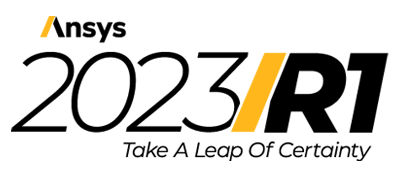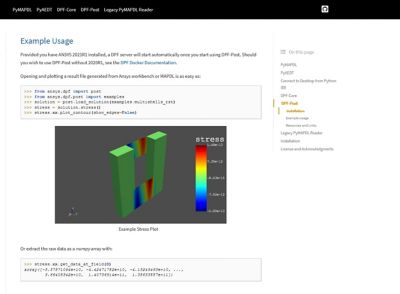-
United States -
United Kingdom -
India -
France -
Deutschland -
Italia -
日本 -
대한민국 -
中国 -
台灣
-
앤시스는 학생들에게 시뮬레이션 엔지니어링 소프트웨어를 무료로 제공함으로써 오늘날의 학생들의 성장을 지속적으로 지원하고 있습니다
-
제품군
모든 제품 보기앤시스는 학생들에게 시뮬레이션 엔지니어링 소프트웨어를 무료로 제공함으로써 오늘날의 학생들의 성장을 지속적으로 지원하고 있습니다
-
앤시스는 학생들에게 시뮬레이션 엔지니어링 소프트웨어를 무료로 제공함으로써 오늘날의 학생들의 성장을 지속적으로 지원하고 있습니다
ANSYS BLOG
October 8, 2021
Ansys Gets Into Open Source With GitHub
For the first time in our history, Ansys is releasing software into the open source. The software is PyAnsys, a family of Python packages providing a new, unified and modern programmable interface to the company’s proprietary simulation stack. With PyAnsys we embrace the vibrant Python ecosystem and speak the language of today’s software developers and users. The initial offering includes packages to interface with Mechanical APDL, a multiphysics simulation and equation solver, DPF, a scalable data processing framework, and AEDT, the Ansys Electronics Desktop. More libaries are already under development.
A stress plot example shown on the PyAnsys GitHub documentation site.
Ansys On GitHub
你知道GitHub,代码托管平台form that enables developers to work together on software. It is part code repository, part version control system and part open-source collaboration community. The platform takes its name from Git, a version control system favored by today’s developers. The “Hub” refers to the social media-like aspects of the site that allow people to gather and contribute to all stages of a software development project, from design and creation to deployment and maintenance.
Development communities in GitHub have emerged around hot topics – such as machine learning, computer vision and other subsets of artificial intelligence – and advanced them significantly with their contributions. Today the site is home to more than 100 million repositories and used by more than 50 million developers from more than 3 million organizations. And now Ansys is officially one of those organizations.
Batteries Included in New Release of PyAnsys
PyAnsys emerged organically within the open-source community. It was started by an Ansys user who sought the expressive syntax of the Python language to easily pilot the Mechanical APDL solver. That user, Alex Kaszynski, first shared his code on GitHub in 2016 and, since then, it has gathered a growing audience. Today, Kaszynski is part of a team at Ansys who are taking the concept to the next level. This first release reflects their work and dedication.
Ansys is launching four GitHub repositories for this next generation of PyAnsys: PyMAPDL, PyDPF-Core, PyDPF-Post, and PyAEDT.PyMAPDLis the interface to our multiphysics simulation and equation solver that will make it easily accessible in Python.PyDPF-Corepresents a data-processing framework that enables users to read and transform simulation data across domains with the help of scalable operators.PyDPF-Postcan be used to extract actionable insights from finite element simulations via a streamlined post-processing interface. PyAEDT consolidates and extends all existing functionalities around scripting for Ansys Electronics Desktop (AEDT) into a Python library that interacts directly with the AEDT API to make scripting simpler for the end user.
The PyAnsys packages will be in the open source under an MIT license and help our customers integrate Ansys proprietary products, such as MAPDL and DPF, into new applications.
For convenience, PyAnsys is also publishing installable packages onto the Python Package Index (PyPI). Documentation and demos have also been crafted to give our users a head start. After all, with PyAnsys we believe the “batteries included” ethos of the Python ecosystem should apply to our simulation stack as well.
Expanding Open-Source Benefits
With PyAnsys, the power of Ansys technology is now easy to harness in Python. Users who want to craft specialized solutions may wish to consider PyAnsys for their own use and even contribute to the project themselves. We invite them to use PyAnsys to automate their design processes, to drive novel applications, to power scientific breakthroughs, and more. By combining a robust community of peers, a programming language such as Python that encourages reuse, and our state-of-the-art simulation stack, the possibilities are endless.
We hope to engage with many Ansys users on GitHub to expand this project and we look forward to officially working with the open-source community on behalf of Ansys!
Learn more atgithub.com/pyansysanddocs.pyansys.com
Ansys가 귀사를 위해 무엇을 할 수 있는지 알아보십시오.
Ansys가 귀사를 위해 무엇을 할 수 있는지 알아보십시오.
문의하기
문의해 주셔서 감사합니다!
We’re here to answer your questions and look forward to speaking with you. A member of our Ansys sales team will contact you shortly.













